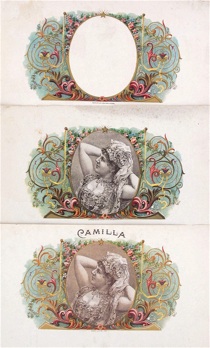In the early 1890’s it became technologically possible to screen photo in such a way they could be lithographed. This “half-tone” process meant that a blank stock label could add any snapshot, including those from the new Kodak cameras that brought photography to the masses. The cigar selling and smoking public responded enthusiastically to what became the ultimate in personalized private labels.
Self portraits of mustachioed proprietors were popular choices, with children running a close second. Anything that anyone was proud of could be, and was, incorporated into a cigar label. Mementos of events and awards appeared on labels, as did many a hunting trophy and championship animal. Proprietors of stores often put their business or local landmark on a label. Sports teams, clubs and local bands used boxes of cigars displaying their portraits as fund-raisers. You’ll find ships, trains, fire trucks and oil gushers among surprises in this exhibit.
Among themselves, printers and box makers call them vanity labels. Turn-of-the-century label catalogs call them a more polite portrait labels or half-tones. Labels with pictures of people were referred to as portrait labels and those with animals, buildings, events and the like were usually called half-tones in most label catalogs. Collectors generally refer to both as Vanity Labels.
Vanity labels appear to have reached their height of popularity between 1901 and 1910 as a lopsided majority of the vanity boxes found today date from that decade. Just as small factories began to disappear after World War One, so too did vanity labels. The Great Depression of the 1930’s curtailed their use even further as did changes in box making technology of the 1940’s. By the 1950’s vanity labels were seldom seen.
Vanity labels are personal favorites of mine.




